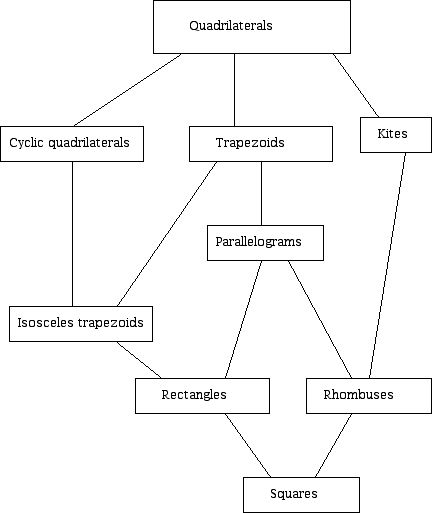
Figure 1
Quadrilaterals
Prepared by:
Joseph Malkevitch
Department of Mathematics
York College (CUNY)
Jamaica, New York 11451
email:
malkevitch@york.cuny.edu
web page:
http://york.cuny.edu/~malk
Unhappily a very large part of the curriculum of K-10 in geometry is devoted to recognizing various shapes and assigning them names. While this certainly enhances the important skill of being able to tell if something is the same or different, I hope that the materials developed for these Geometric Structures pages give a richer vision of geometry.
However, teachers do need to know the basics about the important shapes that we see around us. Prof. Zalman Usiskin (and co-authors) has written a wonderful monograph called: The Classification of Quadrilaterals, the Study of a Definition. This book talks about the many inequivalent definitions of different well known shapes such as rhombuses, kites, and trapezoids. The book also discusses issues related to different points of view in the ways that the same shape can be defined, in terms of the goals that a teacher of geometry might have. Is it a good idea or a bad idea that every square should be considered to be a rectangle, even though not every rectangle (as usually defined) will be a square. The diagram below is "inspired" by Usiskin's book and shows relationships between the usual definitions of the shapes mentioned in the diagram. A segment connecting two terms or a path connecting two terms, from a term X to a term Y ABOVE it, means that every X is also a Y. Thus, every square is a parallelogram and every rhombus is a kite.
A very different approach to naming quadrilaterals was offered by the geometer Branko Grünbaum which was expanded into an approach suitable for lower grades by Orlando Alonso in his doctoral thesis at Teachers College. This approach builds on ideas that I have tried to promote concerning the using of the concept of the partition of an integer to inspire new ways of looking a geometrical problems. There are 5 partitions of 4: {4}, {3, 1}, {2, 2}, {2, 1, 1}, and {1, 1, 1, 1}.

References:
Alonso, Orlando B. Making sense of definitions in geometry: Metric-combinatorial approaches to classifying triangles and quadrilaterals (Doctoral dissertation-Teachers College). New York City, NY, 2009.
Alonso, Orlando B. “Grünbaum 's convex quadrangles enumeration and an extension of the angle-side reciprocity of quadrangles.” Geombinatorics 20, no. 2 (2010): 45-47.
Alonso, Orlando B., and Joseph Malkevitch. “Enumeration via partitions.” Consortium 98 (2010): 17-21. (Consortium is the newsletter of COMAP, the Consortium for Mathematics and Its Applications.)
Grünbaum, Branko. “The angle-side reciprocity of quadrangles.” Geombinatorics, no. 4 (1995): 115-118.
Senechal, M. Visualization and Visual Thinking. In J. Malkevitch (Ed.), Geometry's Future. Arlington, MA: COMAP, (1991): 15-21.
Usiskin, Zalman, and Jennifer Griffin. The classification of quadrilaterals: A study of definition. Charlotte, NC: Information Age Publishing, 2008.